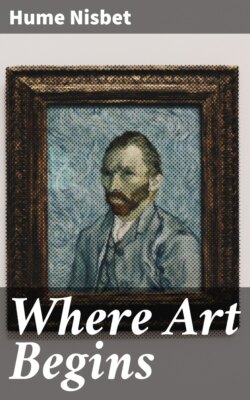Where Art Begins

Реклама. ООО «ЛитРес», ИНН: 7719571260.
Оглавление
Hume Nisbet. Where Art Begins
Where Art Begins
Table of Contents
INTRODUCTION
ILLUSTRATIONS
WHERE ART BEGINS
A WORD BEFORE
CHAPTER I. WHERE ART BEGINS
POSING
LIGHTING
RETOUCHING
CHAPTER II. A STUDY IN LIGHT AND SHADOW
CHAPTER III. THE PRIMARIES: YELLOW, RED, AND BLUE
I. AN APOLOGY TO THE AUTHOR OF ‘MODERN PAINTERS,’ ETC
II. THE PRIMARIES: YELLOW, RED, AND BLUE
CHAPTER IV. ART IN ITS RELATIONSHIP TO EVERYDAY LIFE
CHAPTER V. ON PICTURE LIGHTING
CHAPTER VI. SHIPS: ANCIENT AND MODERN
CHAPTER VII. ILLUSTRATIVE ART: PAST AND PRESENT
CHAPTER VIII. ART IN MINOR DIRECTIONS
THE ART OF GRAINING
THE ART OF OAK IMITATION—OAK GRAINING
THE IMITATION OF SOFT WOODS
MAPLE WOOD
MAHOGANY AND WALNUT
ON THE IMITATION OF MARBLES—BLACK AND GOLD
DOVE MARBLE
CHAPTER IX. DRESS AND DECORATION
DRESS
DECORATION
CHAPTER X. SOME OF THE OLD MASTERS
A CURSORY EXAMINATION
CHAPTER XI. THE SACRED AND THE COMIC SIDES OF ART
PART I.—THE SACRED SIDE OF ART
PART II.—THE COMIC SIDE OF ART
CHAPTER XII. ON VARIOUS SUBJECTS CONNECTED WITH ART
EX LIBRIS
BOOK PLATES
ARTISTIC ASTRONOMY
ARTISTIC BOTANY
THE SPIRIT OF BEAUTY
THE BUTTERFLY SYMBOL OF ART
CHAPTER XIII. NATURE WORSHIP
INDEX
Отрывок из книги
Hume Nisbet
Published by Good Press, 2021
.....
I know also that it was long considered by some professional men to be false art to touch a plate after developing, as it is sometimes still regarded as wrong for an artist to use the compasses or straight-edge to save time with a drawing, but I consider these as silly prejudices, to laugh at. Personally, I would not hesitate for a moment to use either a pair of compasses, a straight-edge, or a photograph, if the so doing served me better than my eye, or my sketch, in the making of my picture; neither would I hesitate to call the man a fool who objected to me doing so on the ground that it was not legitimate art.
Retouching is exactly the same work on the negative as if the artist sat down before any other material. Upon it, if he has the genius, he can do almost anything, so that he has shadow enough as a basis. Here he becomes, as I have said, the creator, and of all the different operations of a negative, this is the portion where the artist stands out most prominently and proves what stuff he or she is made of. There is no end to the variety of work they may introduce as they work on—grains to look like engravings, hatchings, stippling, brush work. It is not enough to be able to remove spots and blemishes, or soften off harsh contrasts; girls mostly get up to this mark of excellence, and produce those smooth, meaningless, pleasant portraits of everyday life. The retoucher must learn to keep an expression of the negative, or make one if not there, and this is the lofty calling of a true retoucher. He must put a soul into his model, else he cannot call himself an artist any more than the painter can claim the title who only daubs potboilers. But if the retoucher can do this, and has art enough in himself to prefer soul to beauty or beautifying, then he has as much claim to call himself a painter or an artist (if he prefers that title) as any R.A. in the clique divine.
.....